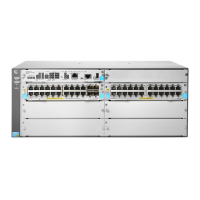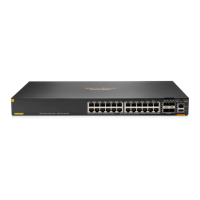1
Configuring Ethernet interfaces
The Switch Series supports Ethernet interfaces, management Ethernet interfaces, Console
interfaces, and USB interfaces. For the interface types and the number of interfaces supported by a
switch model, see the installation guide.
This chapter describes how to configure management Ethernet interfaces and Ethernet interfaces.
Ethernet interface naming conventions
The Ethernet interfaces are named in the format of interface type A/B/C. The letters that follow the
interface type represent the following elements:
• A—IRF member ID. If the switch is not in an IRF fabric, A is 1 by default.
• B—Slot number. 0 indicates the interface is a fixed interface of the switch.
• C—Port index.
A 10-GE breakout interface split from a 40-GE interface is named in the format of interface type
A/B/C:D. A/B/C is the interface number of the 40-GE interface and D is the number of the 10-GE
interface, which is in the range of 1 to 4. For information about splitting a 40-GE interface, see
"Splitting a 40-GE interface and combining 10-GE breakout interfaces."
Configuring a management Ethernet interface
A management interface uses an RJ-45 connector. You can connect the interface to a PC for
software loading and system debugging, or connect it to a remote NMS for remote system
management.
To configure a management Ethernet interface:
Step Command Remarks
1. Enter system view.
system-view
N/A
2. Enter management
Ethernet interface view.
interface
M-GigabitEthernet
interface-number
N/A
3. (Optional.) Set the
interface description.
description
text
The default setting is
M-GigabitEthernet0/0/0 Interface
.
4. (Optional.) Shut down
the interface.
shutdown
By default, the management Ethernet
interface is up.
Configuring common Ethernet interface settings
This section describes the settings common to Layer 2 Ethernet interfaces, Layer 3 Ethernet
interfaces, and Layer 3 Ethernet subinterfaces. For more information about the settings specific to
Layer 2 Ethernet interfaces or subinterfaces, see "Configuring a Layer 2 Ethernet interface." For
more info
rmation about the settings specific to Layer 3 Ethernet interfaces or subinterfaces, see
"Configuring a Layer 3 Ethernet inte
rface or subinterface."

